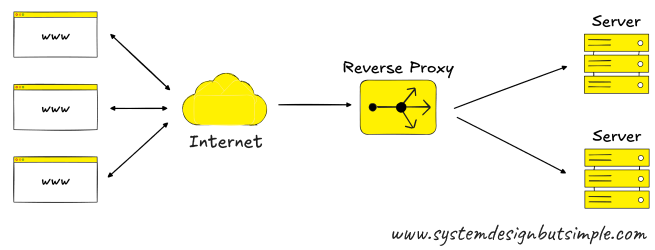Reverse Proxy in 1 diagram and 188 words
Explained as simply as possible… but not simpler.
A reverse proxy is a server that sits between clients and backend servers, forwarding client requests to the appropriate backend and returning the response as if it came from the proxy itself.
In modern web architectures, reverse proxies are used to manage traffic, improve performance, and add security between users and backend services. They are essential in scaling and securing applications across multiple servers.
Use it when you want to load balance traffic, protect backend services, or centralize concerns like caching and SSL.
You need to know
Load Balancing: A reverse proxy can distribute incoming traffic across multiple backend servers to improve scalability and reliability.
SSL Termination: It can handle SSL/TLS decryption so backend services can run plain HTTP, reducing their complexity.
Security & Caching: It can hide backend server details, block malicious traffic, and cache static content to reduce load on servers.
Popular technologies
NGINX - High-performance reverse proxy often used for load balancing and caching.
HAProxy - A reliable and efficient proxy commonly used in high-throughput, low-latency environments.
Traefik - A modern reverse proxy with built-in support for dynamic service discovery and Let's Encrypt.
Like posts like this?
Every week, you'll get a new system design concept, broken down like this one.
Free subscribers also get a little bonus:
🎁 The System Design Interview Preparation Cheat Sheet
If you're into visuals, paid subscribers unlock:
→ My Excalidraw system design template – so you have somewhere to start
→ My Excalidraw component library – used in the diagram of this issue
No pressure though. Your support helps me keep writing, and I appreciate it more than you know ❤️



